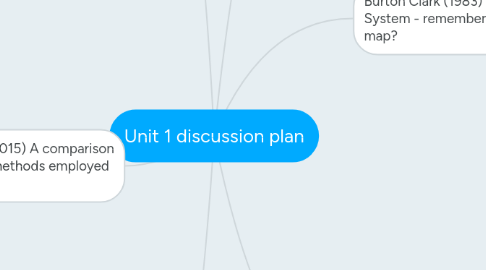
1. Maassen (2000) HE Research - hourglass structure & implications
1.1. Growth of HE research brought by researchers from other disciplines
1.2. Hourglass model - meeting point for disciplinary and HE researchers
1.2.1. One side - disciplinary researchers provide theoretical frameworks for analysis
1.2.2. Other side - HE researchers apply them in HE research
1.3. HE research hardly contribute to mother dicsiplines
1.4. HE research focused on practicality - pressure to findings that can be put into immediate practical use
1.5. Differences in USA and continental Europe HE research, USA - micro and meso level, Europe - role of state in addition to micro and meso
1.6. Implications - HE need to contribute to theoretical/conceptual state of mother disciplines
2. Trow (1970) Mass to Universal HE
2.1. Autonomous and popular functions of American HE - Remember Manuel Castells???
2.2. US HE is successful - provides a model for reformers in continental Europe and elsewhere
2.3. High participation rates - almost universal
2.4. Still with challenges
2.5. Academic divisions of labour between and within institutions
2.6. Most institutions serve a single function, either popular or autonomous
2.7. Popular and autonomous functions are insulated
2.8. Black studies and black students
3. Wells et al. (2015) A comparison of research methods employed in HE
3.1. Replication study to examine methodological changes in HE research after a decade
3.2. Initial study recommended HE programs to adjust their graduate research training to match those of professional journal articles
3.3. Quantitative methods still dominate HE research in professional articles after a decade with some noticeable shifts
3.4. Advanced statistics dominant
3.5. More intensive research methods training needed for HE personnel
3.6. striking a balance - equip students with advanced statistical skills but also avoid delegitimizing alternative ways of knowing
4. Castells (2001) Contradictory Functions
4.1. Formation & diffusion of ideology
4.2. Mechanisms of selection of dominant elites
4.3. Research i.e generation of new knowledge
4.4. Training of bureaucracy - skilled labour force
4.5. Contradictory? - Universities face a lot of pressure from the society beyond the 4 functions - the whole process lead to a complex and contradictory reality
4.6. critical element in the structure and dynamics of university systems is to combine and make compatible seemingly contradictory functions i.e managing contradictory functions within the same system is a challenge
4.7. because universities are social systems and historically produced institutions”, they undertake all of the four functions simultaneously within the same structure – although with different emphases at different historical moments - Remember Wittrock and history?
5. Wittrock (1993) The modern university: three transformations
5.1. First transformation: Berlin 1810 - foundation of the modern university
5.1.1. University underwent processes of revitalization
5.1.2. radical innovations in Germany Universities
5.1.3. Humbolt ideas influential
5.1.4. Essential dimensions of university program
5.1.4.1. Autonomy from state - academic freedom
5.1.4.2. philosophical unity of scholarship
5.1.4.3. Bildung - formation of character thr' learning
5.1.4.4. Pursuit of truth as an endless process - remember Clark???
5.2. Second transformation:
5.2.1. The rise of the research University 1870 - 1914
5.2.1.1. Growth of modern science
5.2.1.2. research became a major mission of many universities
5.2.1.3. universities became core institutions for modern states and modern economies
5.3. Third transformation: The 'Mass University' After 1945
5.3.1. expansion and transformation in the second half of the twentieth century
5.3.2. Initially in USA in 1960's
5.3.3. Era of transition from elite to mass HE systems - Remember Martin Trow????
